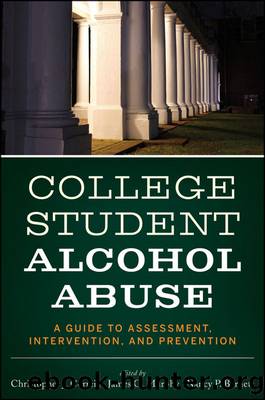College Student Alcohol Abuse by Murphy James G.;Barnett Nancy P.;Correia Christopher J.; & James G. Murphy & Nancy P. Barnett

Author:Murphy, James G.;Barnett, Nancy P.;Correia, Christopher J.; & James G. Murphy & Nancy P. Barnett
Language: eng
Format: epub
ISBN: 1029216
Publisher: John Wiley & Sons, Incorporated
Published: 2012-09-05T00:00:00+00:00
RECOMMENDATIONS AND CONSIDERATIONS FOR CAMPUS AND COMMUNITY ADMINISTRATORS
In this section, practical guidelines are provided for college and university officials interested in implementing environmental strategies in order to assist in the process of selection and implementation.
Identification of Campus-Specific Needs
Administrators and prevention specialists should identify key on-campus personnel who can be involved in addressing alcohol-related concerns. Individuals from a variety of campus departments (e.g., president, student affairs, substance abuse services, health services, residence life, counseling center, faculty with related interests) can mobilize as a formal group. Campus officials should then reach out to key individuals in the community, including law enforcement, owners or managers of alcohol establishments, administrators at other local colleges, and community or school-based prevention specialists. Many universities already have a campus-community coalition or task force that can focus toward a common set of agreed-upon goals.
Campus and community administrators should become knowledgeable about the extent of alcohol use behaviors and alcohol-related harms among students and in the local community [see Busteed (2002) for a number of âbenchmark indicatorsâ]. Administrators may have access to data on student alcohol-related behaviors as part of surveys conducted through student affairs or elsewhere. It is important to also track general trends in alcohol-related medical transports, on-campus substance-related infractions, and local police reports involving students in order to consider how to best direct university resources and assist students (DeJong, 2008; DeJong & Langford, 2006). As described by Neighbors and colleagues (2007), administrators and staff can monitor and target particular events (e.g., sports events, spring break, âGreek weekâ among fraternity and sorority members) or time periods (e.g., move-in period prior to the beginning of classes). One strategy that may reduce pregaming is altering the floor checking schedules of the resident assistants prior to major campus or nearby community events.
Other factors to consider include the number of alcohol establishments in the surrounding communities. Given the association between alcohol outlet density and alcohol use and problems, university staff can work with local municipalities to limit alcohol availability through licensing regulation. In addition, university staff can assist in targeting off-campus neighborhoods that have issues related to student parties (e.g., alcohol-impaired driving, noise, litter) in cooperation with local law enforcement and groups such as realtors, neighborhood associations and municipal governments (DeJong & Vehige, 2008). It is worth emphasizing that colleges and universities with alcohol bans should still carefully consider which alcohol-related behaviors are important targets for environmental strategies, since drinking and related harms remain a concern despite the existence of such policies (Wechsler et al., 2001a).
Selection and Implementation of Environmental Strategies
Ideally, campus and community officials would work collaboratively in selecting alcohol-related behaviors to be targeted as well as the intervention strategies to be implemented (Wagenaar et al., 1999). As highlighted in the preceding section, the process of selecting environmental strategies for reducing alcohol-related harms should be informed by the results of a needs assessment for the particular campus (DeJong, 2009; Hingson & Howland, 2002). For example, colleges or universities may offer a disproportionally low number of classes on Friday mornings. Accordingly,
Download
This site does not store any files on its server. We only index and link to content provided by other sites. Please contact the content providers to delete copyright contents if any and email us, we'll remove relevant links or contents immediately.
Unwinding Anxiety by Judson Brewer(72700)
The Art of Coaching by Elena Aguilar(52869)
The Fast Metabolism Diet Cookbook by Haylie Pomroy(21038)
Rewire Your Anxious Brain by Catherine M. Pittman(18516)
Healthy Aging For Dummies by Brent Agin & Sharon Perkins RN(16983)
Talking to Strangers by Malcolm Gladwell(13171)
The Art of Thinking Clearly by Rolf Dobelli(10167)
Mindhunter: Inside the FBI's Elite Serial Crime Unit by John E. Douglas & Mark Olshaker(9144)
Crazy Rich Asians by Kevin Kwan(9144)
The Compound Effect by Darren Hardy(8769)
Tools of Titans by Timothy Ferriss(8178)
Periodization Training for Sports by Tudor Bompa(8129)
Becoming Supernatural by Dr. Joe Dispenza(8073)
Wonder by R. J. Palacio(7936)
Crystal Healing for Women by Mariah K. Lyons(7841)
Bodyweight Strength Training by Jay Cardiello(7822)
Therapeutic Modalities for Musculoskeletal Injuries, 4E by Craig R. Denegar & Ethan Saliba & Susan Saliba(7675)
Change Your Questions, Change Your Life by Marilee Adams(7596)
Should I Stay or Should I Go? by Ramani Durvasula(7535)
